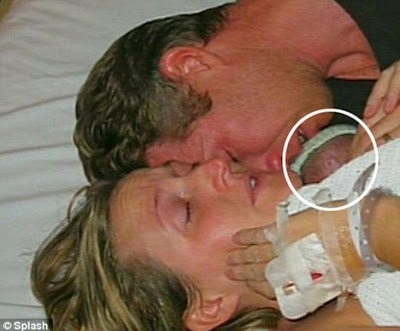After Australian mom Kate Ogg gave birth to premature twins at 27 weeks gestation, her doctor gave her the news no mother wants to hear. One of the twins, a boy, didn’t make it, but that’s just the beginning of this heartwarming story.
The doctor, who struggled for 20 minutes to save the infant before declaring him dead, gave the 2-pound lifeless baby to Kate and her husband David to say their goodbyes. Kate instinctively placed her naked newborn son, named Jamie, on her bare chest.
As the grieving parents embraced and talked to Jamie for two hours, he began gasping for air. At first the doctors dismissed it as a reflex. However, the gasps continued more frequently and he began showing other signs of life. Kate gave Jamie some breast milk on her finger. Amazingly, he took it and began to breathe normally.
Kate recalled, “A short time later he opened his eyes. It was a miracle. Then he held out his hand and grabbed my finger. He opened his eyes and moved his head from side to side. The doctor kept shaking his head saying, ‘I don’t believe it, I don’t believe it.’”
The technique which Kate Ogg used to revive her baby, placing the infant skin-to-skin with the mother or father, is known as Kangaroo Care or Kangaroo Mother Care, a practice endorsed by the World Health Organization for use with premature infants. Pre-term and low birth-weight babies treated with the skin-to-skin method have been shown to have:
- lower infection rates,
- less severe illness,
- improved sleep patterns and
- are at reduced risk of hypothermia.
Skin-to-skin care also helps build a long-term impact between the mother and the baby as the newborn recognises the smell and taste of the mother. Some experts believe a skin-to-skin approach is more beneficial than taking newborn babies into intensive care incubators.


